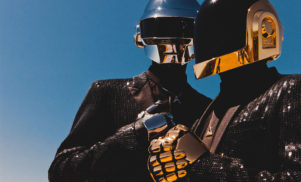Any attempt to codify the canon of a genre of art is met with two basic types of complaints.
The first is simple: the author is wrong. Something is missing, something is too low, something is too high, and no fucking way is whatever is at the top supposed to be at the top. The second complaint is existential: there are so many questionable inclusions, obvious omissions and shafted classics that the author might be from an alternate universe.
The complaints about Thump’s 99 Greatest Dance Albums of All Time are almost entirely of the second type. It’s not that it’s a bad list, because it’s not: it’s a fairly succinct catalog of the albums that define “dance music” to a certain demographic. The problem is, that demographic – American millennials – lacks clout in the global dance community. To rave veterans, the idea that Discovery should top the list when Warp Records are nowhere to be seen is insane, as is the idea that Britney Spears even belongs in the same parallax scroll column as Drexciya.
It’s easy (and fun!) to take folks down a peg when they so brazenly seem to fuck up their history. But the real problem here is how meaningless the term “dance music” truly is. America may have invented house and techno (and, contrary to popular belief, has always nurtured healthy scenes), but much of the country more or less saw dance music as synonymous with A Night At The Roxbury until the 2000s. When hipster dance parties became a thing, the music was DFA remixes, New Order and Abba and the DJs were rap vets diversifying as fast as they could find the records, or house heads tweaking their sets for greener crowds. There were also just guys playing after-parties for their bands with crates full of dollar disco and singles lifted from the college radio station. Sometimes it was just some kid with an iPod (or a Discman!).
The primordial ooze of this scene was made up of folks who could all agree on Daft Punk, blew fat rails of Justice, would learn to embrace the joyous idiocy of Tiësto and Swedish House Mafia, and would have to own Kaskade. They worked backwards as they went forward, learning about (or rediscovering) Carl Craig and Plastikman. They might have never heard of Underworld without Trainspotting, but is that really their fault?
That said, the Thump list’s almost total lack of hip-hop and R&B is cringeworthy. The inclusion of Missy Elliot is cool, but it’s hard to justify other choices: Dizzee Rascal’s American fanbase was largely indie rock fans who wanted some rap to call their own and, while I love Kid Sister, it’s a hell of a reach to call her album important. Putting Gwen Stefani’s yodeling ass on the list is egregious; if there’s room for her, there’s room for Kanye, Pharrell, Luda, Destiny’s Child, Ciara and 2 Live Crew as well. If there’s room for DJ Shadow, there’s room for Dilla.
So is the Thump list a good list of the 99 best dance albums of all time? Nah. But it does capture a particular and important perspective on the history of dance music. It might be a (debatable but still acceptable) list of the most influential dance albums in America. At the very least, anyone in the UK having a laugh right now should remember this moment the next time anyone in Europe tries to list the best rap albums of all time.































